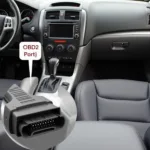The dreaded Check Engine Light, a beacon of automotive anxiety, can illuminate for various reasons. One of the most common culprits, particularly among gasoline engines, is the OBD2 code P0301 – a cryptic sequence signaling a “Cylinder 1 Misfire Detected.” This article delves into the intricacies of this code, deciphering its meaning, outlining its potential causes, and guiding you through the diagnostic and repair process.
Understanding OBD2 Code P0301
Before we can tackle the problem, we need to understand what the code signifies. A P0301 code specifically indicates that your car’s computer, the Engine Control Module (ECM), has detected a misfire in cylinder number one.
A misfire occurs when the air-fuel mixture in a cylinder fails to ignite properly, disrupting the engine’s combustion cycle. This can lead to a loss of power, increased emissions, and potential damage to your engine if left unaddressed.
Common Causes of a P0301 Code
A myriad of issues can trigger a P0301 code, ranging from simple fixes to more complex problems. Here’s a breakdown of the most common culprits:
- Faulty Spark Plug: A worn-out or fouled spark plug in cylinder 1 is a leading cause of misfires. The spark plug provides the electrical spark needed to ignite the air-fuel mixture.
- Worn Spark Plug Wires: Similar to spark plugs, damaged or worn spark plug wires can disrupt the electrical current flow, causing a weak spark or no spark at all.
- Clogged or Faulty Fuel Injector: A clogged fuel injector restricts the amount of fuel delivered to the cylinder, while a faulty one may not deliver fuel at all, leading to a lean air-fuel mixture and misfires.
- Vacuum Leak: A leak in the intake manifold or vacuum hoses can disrupt the air-fuel ratio, causing a lean mixture and misfires, particularly in a specific cylinder.
- Compression Issues: Problems with the piston rings, cylinder walls, or valves in cylinder 1 can lead to low compression, hindering proper combustion and causing misfires.
- Ignition Coil Failure: The ignition coil is responsible for generating the high voltage needed by the spark plug. A failing coil can cause weak or inconsistent sparks, leading to misfires.
Diagnosing a P0301 Code
Diagnosing a P0301 code often involves a systematic approach to pinpoint the root cause. Here’s a step-by-step guide to help you:
- Check for Obvious Signs: Begin by inspecting the spark plug and wire in cylinder 1 for visible damage, wear, or loose connections.
- Swap Components: If the spark plug and wire appear fine, swap them with those from another cylinder. If the misfire follows the swapped components, the problem lies with the spark plug or wire.
- Inspect Fuel Injectors: If the misfire persists in cylinder 1, move on to inspecting the fuel injectors. You can check for a clogged injector by listening for a clicking sound when the engine is running.
- Test for Vacuum Leaks: Use a carburetor cleaner spray around the intake manifold and vacuum hoses while the engine is idling. Any changes in engine speed indicate a vacuum leak.
- Perform a Compression Test: If the previous steps don’t reveal the issue, a compression test can help identify problems with the piston rings, cylinder walls, or valves.
- Check the Ignition Coil: If you suspect a faulty ignition coil, you can test it using a multimeter to measure its resistance.
How to Fix a P0301 Code
Once you’ve identified the cause of the P0301 code, the next step is to address it promptly. Here are some common solutions:
- Replace Faulty Spark Plugs and Wires: If you find a worn or damaged spark plug or wire, replace it with a new one that meets your vehicle’s specifications.
- Clean or Replace Fuel Injectors: If a clogged fuel injector is the culprit, you can try cleaning it using a fuel injector cleaning kit. If cleaning doesn’t resolve the issue, replace the injector.
- Repair Vacuum Leaks: If you detect a vacuum leak, tighten loose clamps, replace damaged hoses, or seal leaks in the intake manifold using a suitable sealant.
- Address Compression Issues: Low compression requires more involved repairs, such as replacing piston rings, honing cylinder walls, or repairing/replacing valves. Consult a qualified mechanic for these repairs.
- Replace Faulty Ignition Coil: If the ignition coil is faulty, replace it with a new one designed for your vehicle’s make and model.
OBD2 Code P0301 FAQs
Q: Can I still drive my car with a P0301 code?
A: While you might be able to drive short distances with a P0301 code, it’s not recommended. Driving with a misfire can damage your catalytic converter and other engine components, leading to more costly repairs down the line.
Q: How much does it cost to fix a P0301 code?
A: The repair costs for a P0301 code can vary significantly depending on the underlying cause. Simple fixes like replacing spark plugs or wires can be relatively inexpensive, while more complex repairs like addressing compression issues can be considerably more costly.
Q: Can a bad oxygen sensor cause a P0301 code?
A: While a faulty oxygen sensor can disrupt the air-fuel mixture and potentially contribute to misfires, it’s less likely to cause a cylinder-specific misfire like the P0301 code.
Need More Help with OBD2 Codes?
For more information on specific OBD2 codes, such as obd2 code p0301 p ford explorer, obd2 code 301, or 2013 ford cmax hybrid obd2 codes p0301, explore our comprehensive database of OBD2 code definitions and troubleshooting guides.
Experiencing a P0301 Code? We Can Help!
A P0301 code, though concerning, is often resolvable with timely diagnosis and repair. Remember, neglecting this issue can lead to more severe engine damage and costly repairs. If you’re facing a P0301 code, don’t hesitate to reach out to our team of expert mechanics for assistance. Contact us via WhatsApp at +1(641)206-8880 or email us at [email protected]. We’re available 24/7 to help you get back on the road safely and quickly.

